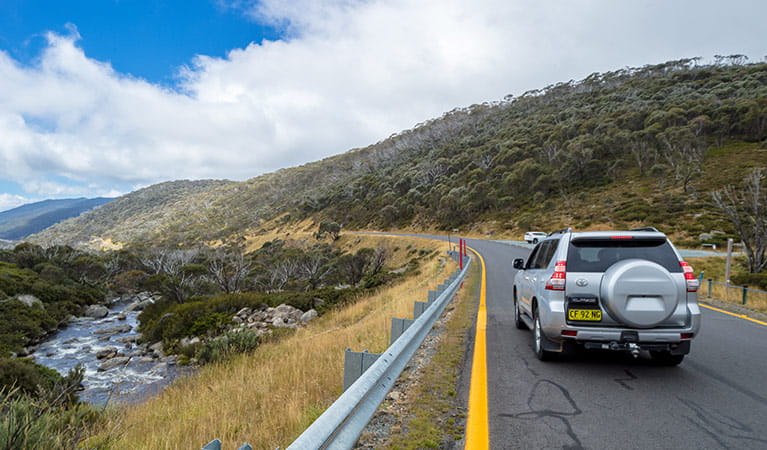Kosciuszko – Alpine Way drive
Kosciuszko National Park
Overview
A driving or motorbike tour along Alpine Way scenic drive is a great way to discover the spectacular mountain views, serene campgrounds, magnificent walks, rides, and heritage of southern Kosciuszko National Park.
- Distance
- 108km one-way
- Entry fees
- Park entry fees apply
- Please note
Alpine Way is steep, narrow and winding between Khancoban and Thredbo, and subject to rockfalls after rain. This section is not recommended for vehicles towing large caravans.
For sweeping mountain views and unending vistas that are sure to clear the head, try a car or motorbike adventure along the magnificent Alpine Way. Linking Jindabyne in the southern reaches of Kosciuszko National Park to Khancoban, near the Victorian border, it’s an iconic road trip for all ages.
Winding through tall mountain forests and past the dramatic western fall of the Main Range, snow-capped peaks can be seen from winter through to spring. You’ll be driving a path well-travelled, rich with historic significance. Aboriginal people travelled this route to the high country, and more recently, it was used as a drover’s stock route and for the Snowy Mountains Hydro-Electric Scheme.
Pack as much or as little adventure into your road trip as you like, with spectacular walking, fishing and mountain biking options along the way. There’s a range of accommodation options on offer too, from Thredbo Alpine Village, to riverside camping at Tom Groggin and Geehi Flats.
Map
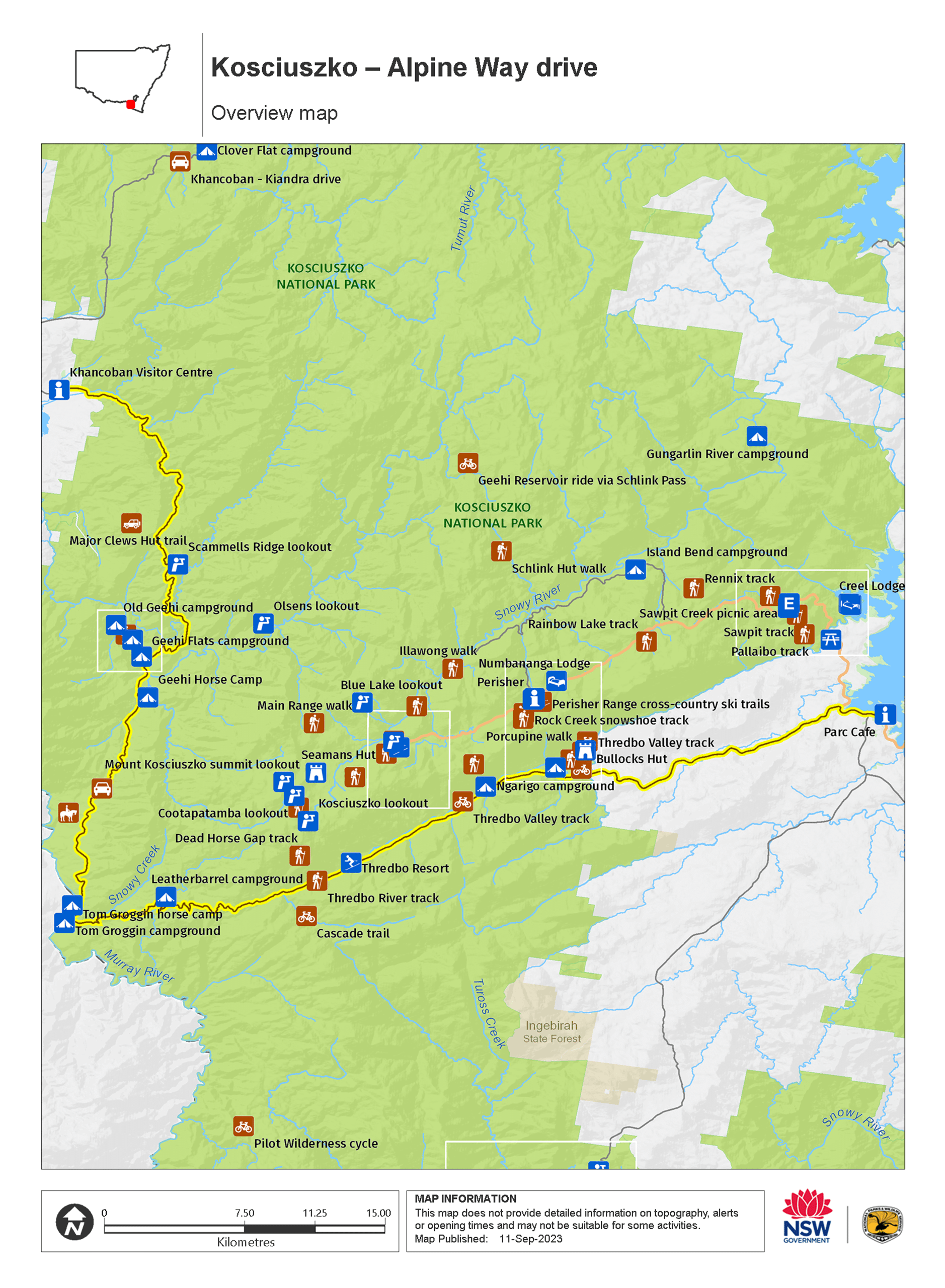
Map
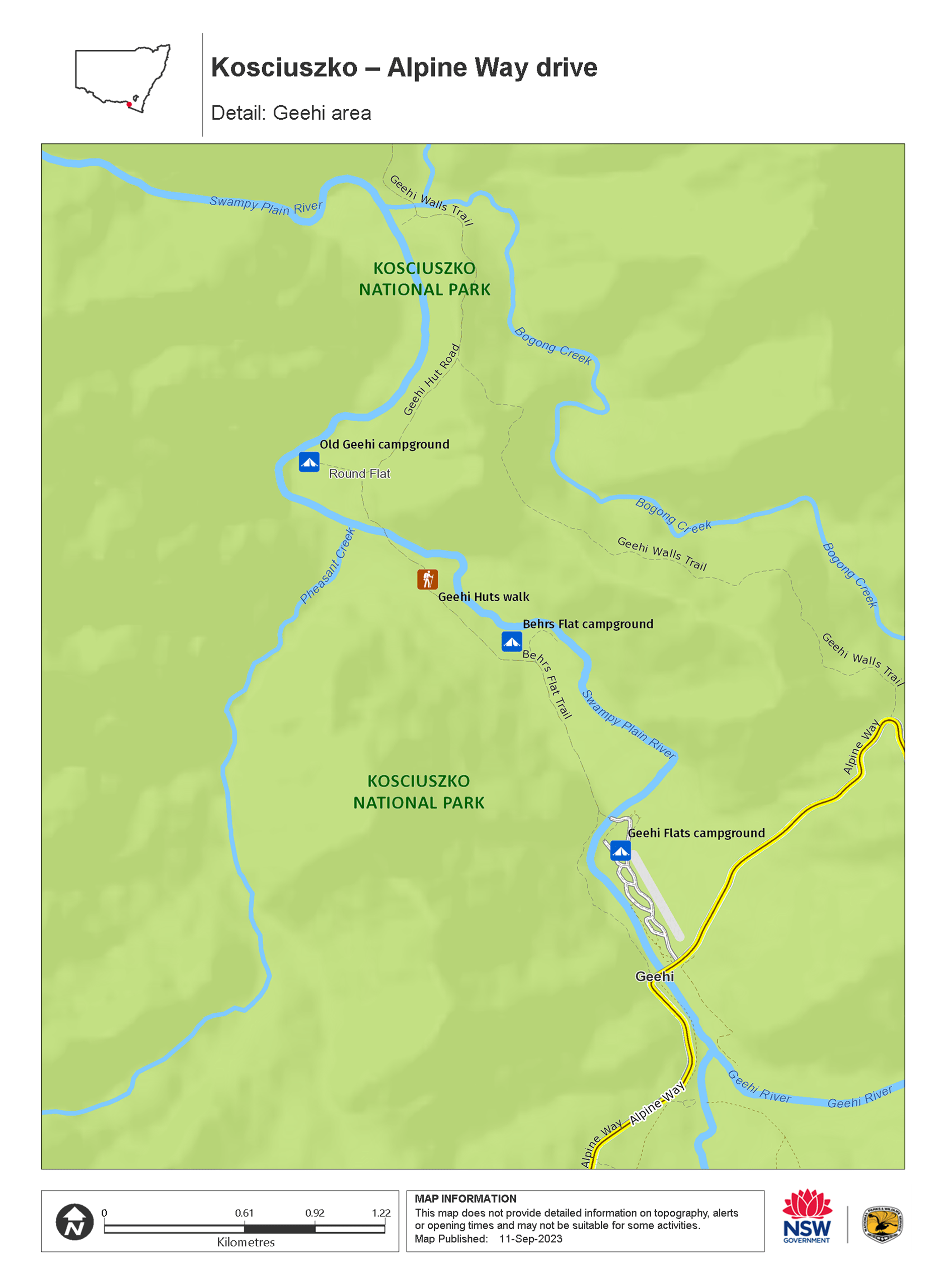
Map
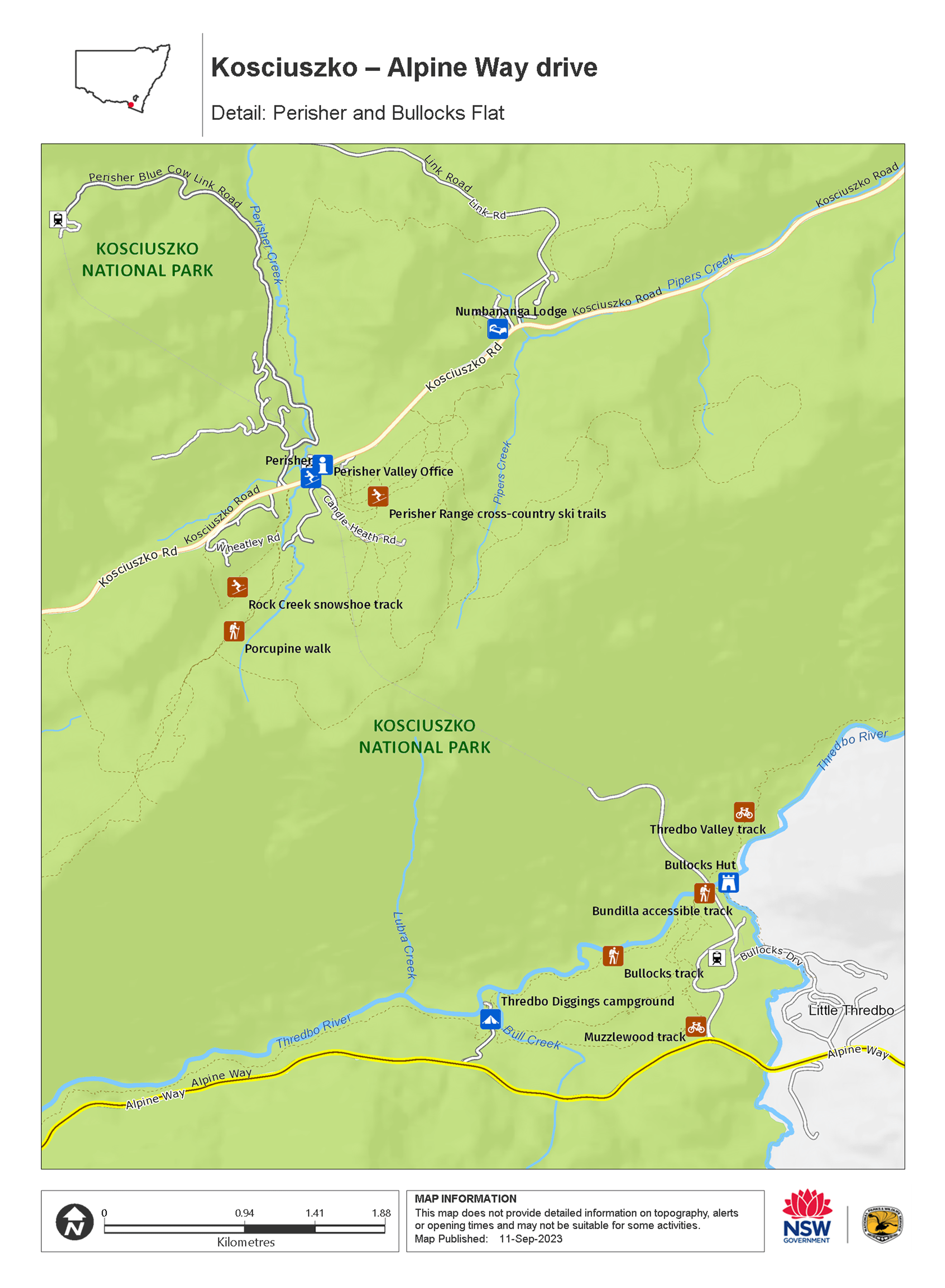
Map legend

Local alerts
For the latest updates on fires, closures and other alerts in this area, see https://www.nationalparks.nsw.gov.au/things-to-do/driving-routes/kosciuszko-alpine-way-drive/local-alerts
General enquiries
- National Parks Contact Centre
- 7am to 7pm daily
- 1300 072 757 (13000 PARKS) for the cost of a local call within Australia excluding mobiles
- parks.info@environment.nsw.gov.au
Park info
- in the Khancoban area of Kosciuszko National Park in the Snowy Mountains region
The Khancoban area is open all year, but access along the Khancoban to Cabramurra Road is closed in winter (June to October long weekends).
-
Park entry fees apply on Alpine Way
Winter (June to October long weekends): $29 per vehicle per day (24hrs from purchase); motorcycles $12; bus passengers $11.45 per adult, $3.60 per child per day. Find out more about the winter entry surcharge.
Rest of Year: $17 per vehicle per day (24hrs); motorcycles $7; bus passengers $6.60 per adult, $2.20 per child per day.
Passes: Single and Multi-Day passes available from Khancoban Visitor Centre's 24-hour vending machines, or via the Park'nPay app.
See vehicle entry fees for other areas in Kosciuszko National Park.
Buy annual pass.
- in the Thredbo-Perisher area of Kosciuszko National Park in the Snowy Mountains region
- The Thredbo-Perisher area is open all year, but some roads and trails may close due to weather conditions or park management issues. Kosciuszko Road is closed between Perisher and Charlotte Pass in winter (June to October long weekends).
-
Park entry fees apply on Alpine Way and Kosciuszko Road
Winter (June to October long weekends): $29 per vehicle per day (24hrs from purchase); motorcycles $12; bus passengers $11.45 per adult, $3.60 per child per day. Find out more about the winter entry surcharge.
Rest of Year: $17 per vehicle per day (24hrs); motorcycles $7; bus passengers $6.60 per adult, $2.20 per child per day.
Passes: Day passes, multi-day passes and annual All Parks Pass available from NPWS visitor centres, local agents and operating vehicle entry stations. Single and Multi-Day passes are also available via the Park'nPay app. Short Breaks Pass: $68 for 5 days park entry at price of 4 days (not valid winter).
Read our Annual Pass FAQs for information.
Buy annual pass.
Visitor info
All the practical information you need to know about Kosciuszko – Alpine Way drive.
Getting there and parking
Get driving directions
Alpine Way scenic drive connects the Khancoban area and Thredbo-Perisher areas of Kosciuszko National Park. To get there:
- From Jindabyne, follow Kosciuszko Road west for 3km then turn left onto Alpine Way.
- From Khancoban, Alpine Way heads south-east and enters the park around 1km from town.
Road conditions
Roads can close in extreme weather. Get live traffic information and check the weather before you go.
Alpine Way is steep, narrow and winding between Khancoban and Thredbo. Rockfalls can happen after rain. This section is not recommended for vehicles towing large caravans.
It's compulsory for all for 2WD vehicles to carry snow chains in winter, between June and October long weekends, on Alpine Way between Thredbo and Tom Groggin. Snow chains are recommended for all vehicles driving in the park, including 4WD and AWD. Read our snow driving in Kosciuszko tips.
- Sealed roads
Vehicle access
- 2WD vehicles
Weather restrictions
- Snow chains required after snow
Parking
Parking is available at various attractions along Alpine Way.
Facilities
Toilets and picnic facilities are located at various sites along Alpine Way Drive, including Bullocks Hut, Thredbo Alpine Village, Geehi Flats campground, Scammells lookout and Khancoban Visitor Information Centre.
Maps and downloads
Accessibility
Wheelchair-accessible facilities are available at several locations along Alpine Way, including:
- Khancoban Visitor Centre
- Scammells lookout
- Geehi Flats campground
- Tom Groggin campground
- Thredbo Alpine Village
Permitted
Camping
Permitted at designated campgrounds accessed along Alpine Way.
Fishing
You can fish in rivers and streams between the October and June long weekends. A current NSW recreational fishing licence is required to fish in all waters. Fishing in dams and lakes is permitted year-round, but some waterways may close temporarily or have restrictions. Refer to the NSW Recreational Freshwater Fishing Guide for information.
Prohibited
Drones
Flying a drone for recreational purposes is prohibited in this area. Drones may affect public enjoyment, safety and privacy, interfere with park operations, or pose a threat to wildlife. See the Drones in Parks policy.
This area may be a declared Drone Exclusion Zone, or may be subject to Civil Aviation Safety Authority (CASA) rules for flying near airports, aerodromes and helicopter landing sites. See CASA's Drone Flyer Rules.
Commercial filming and photography
Commercial filming or photography is prohibited without prior consent. You must apply for permission and contact the local office.
Pets
Pets and domestic animals (other than certified assistance animals) are not permitted. Find out which regional parks allow dog walking and see the pets in parks policy for more information.
If you're travelling through a national park or reserve on a public road you can have pets inside your vehicle. However, you must keep them inside your vehicle while driving through national parks or reserves. You must also comply with any conditions in the park’s plan of management, and you cannot stop to visit the park or use park facilities (unless for safety reasons, or to use publicly accessible toilets).
Smoking
NSW national parks are no smoking areas. The alpine resorts of Thredbo, Perisher, Charlotte Pass, Selwyn, Ski Rider and Kosciuszko Tourist Park are exempt, though some commercial and outdoor places within these resorts may have no smoking areas.
Visitor centre
-
Khancoban Visitor Centre
2 Scammel Street, Khancoban NSW 2642 - Winter (June to September): Open 9am to 4pm Monday to Friday and 10am to 2pm on weekends. Rest of year: Open 9am to 4pm daily. Closed Christmas Day.
- 02 6070 8400
Learn more
Kosciuszko – Alpine Way drive is in Khancoban area. Here are just some of the reasons why this park is special:
Unique landscapes
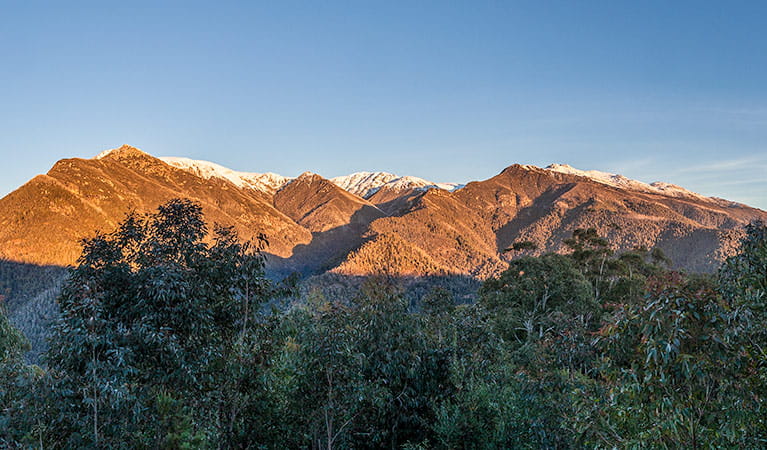
The Western Fall of Kosciuszko National Park’s Main Range is the highest and steepest part of the Snowy Mountains. Mount Townsend and Abbot Peak block the view to Mount Kosciuszko, but their towering, rocky peaks are a breathtaking backdrop to the Geehi Plains, 1600m below. The mountain range captures the westerly air stream allowing tall mountain ash forest to grow in the moist soil below the treeline.
The man-made landscapes of the Snowy Hydro Scheme, one of the civil engineering wonders of the modern world, are also on show. Murray 1 and 2 Power Stations are close to Khancoban, while the scenic drive to Kiandra travels across the very top of the Tumut Pond Reservoir wall.
- Scammells Ridge lookout Scammells Ridge lookout, 1000m above sea level, offers marvellous views of the rugged Western Fall of the Main Range, and makes a scenic picnic spot just off Alpine Way.
Historic alpine huts
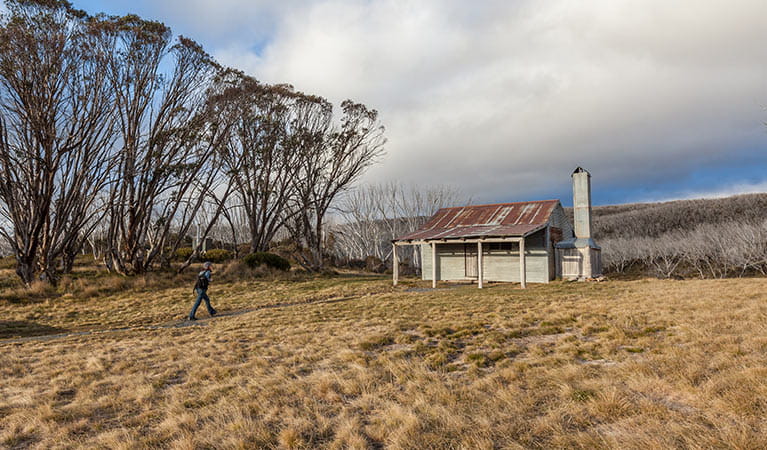
The Khancoban area is home to many of Kosciuszko National Park’s picturesque historic huts. Built as shelter or fishing retreats for graziers and prospectors, or like Major Clews Hut, by Snowy Hydro Scheme workers, the huts provide a window into the past. The 8km return Geehi Huts walk is a great way to see Geehi, Keeble’s and Old Geehi Huts, all constructed from river rocks. Be prepared for several river crossings. Bradleys and O’Brien’s Hut is hard to miss along the Khancoban to Kiandra drive. You can also stretch your legs on a short walk to the rustic Patons Hut or Round Mountain Hut, made out of corrugated iron and surrounded by wilderness.
- Geehi huts walking track Explore Geehi huts walking track by foot, bike, horse or 4WD. This short track, near Khancoban, boasts historic huts, river crossings and magnificent views of the Snowy Mountains in Kosciuszko National Park.
- National trail: Tom Groggin to Geehi Ride, cycle, or hike 21km of National trail in Kosciuszko National Park. Saddle up your horses for a day of high-country adventure on this epic ride from Tom Groggin to Geehi horse camp.
- Round Mountain Hut walking track Round Mountain Hut walking track winds through the Jagungal Wilderness Area in central Kosciuszko National Park. A great Snowy Mountains walk or ride, it offers view and spring wildflowers on its way to the rustic hut.
Discover western and central Kosciuszko
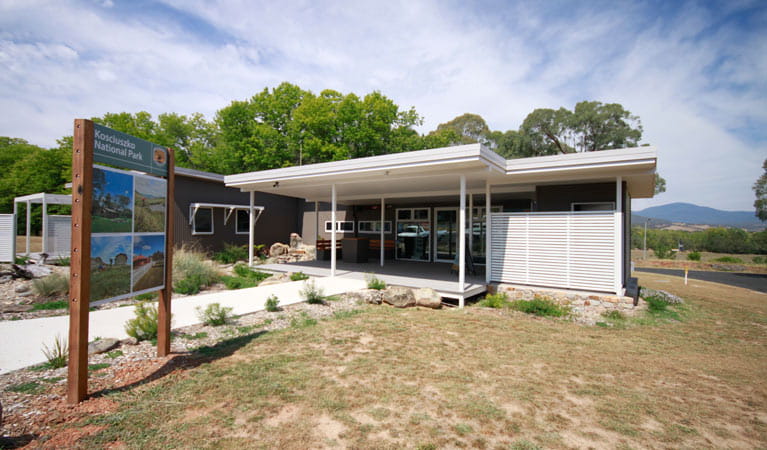
Khancoban Visitor Centre is a convenient stop to buy passes, get maps, information and inspiration before you enter the park. Alpine Way is the main, year-round route through this area. It offers lookouts, campgrounds, picnic areas, walking tracks and bike trails along its 108km length between Khancoban and Jindabyne. The area's upgraded section of the National trail is popular with horse riders, who can also take advantage of horse camps near Geehi and Tom Groggin.
- Khancoban to Kiandra drive Picturesque Khancoban to Kiandra drive links Alpine Way with Snowy Mountains Highway, in Kosciuszko National Park, and takes in scenic dams, historic huts, mountain forest, and the highest town in Australia.
- Khancoban Visitor Centre Khancoban Visitor Centre, on Alpine Way at western entry point to Kosciuszko National Park, is a great place to pick up maps, information and buy a parks pass for your Snowy Mountains adventure.
- Kosciuszko – Alpine Way drive A driving or motorbike tour along Alpine Way scenic drive is a great way to discover the spectacular mountain views, serene campgrounds, magnificent walks, rides, and heritage of southern Kosciuszko National Park.
- National trail: Tom Groggin to Geehi Ride, cycle, or hike 21km of National trail in Kosciuszko National Park. Saddle up your horses for a day of high-country adventure on this epic ride from Tom Groggin to Geehi horse camp.
Remote wilderness and rare species
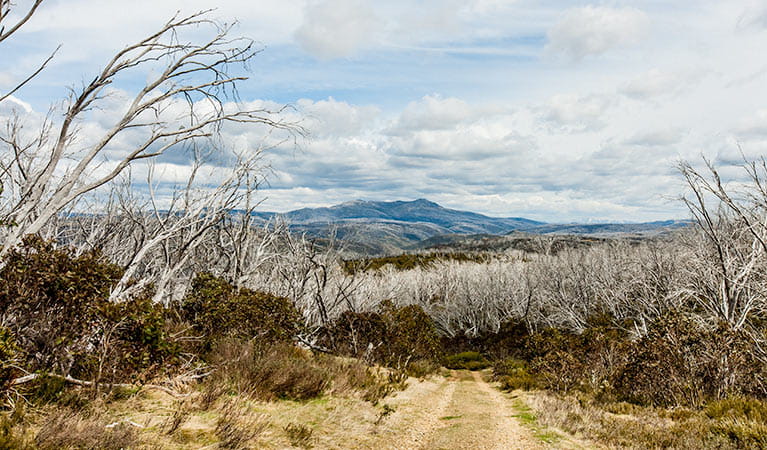
In recognition of Kosciuszko's unique value as a conservation area, it’s been named a UNESCO Biosphere Reserve. More than half of the park, over 350,000ha (almost 865,000 acres), has been declared wilderness, including the Jagungal, Western Fall and Indi wilderness areas, located in the Khancoban area. The park's alpine and sub-alpine areas are home to rare plant species found nowhere else in the world, such as the Southern corroboree frog.
- Round Mountain Hut walking track Round Mountain Hut walking track winds through the Jagungal Wilderness Area in central Kosciuszko National Park. A great Snowy Mountains walk or ride, it offers view and spring wildflowers on its way to the rustic hut.
Plants and animals protected in this park
Animals
-
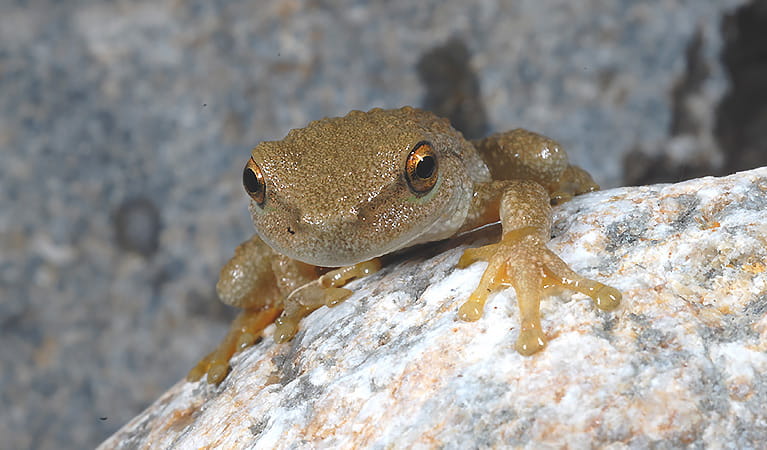
Spotted tree frog (Litoria spenceri)
The spotted tree frog is a rare Australian frog that lives in only a small number of high mountain streams, including a single location in Kosciuszko National Park. It’s listed as critically endangered in NSW.
-

Bare-nosed wombat (Vombatus ursinus)
A large, squat marsupial, the Australian bare-nosed wombat is a burrowing mammal found in coastal forests and mountain ranges across NSW and Victoria. The only other remaining species of wombat in NSW, the endangered southern hairy-nosed wombat, was considered extinct until relatively recently.
-
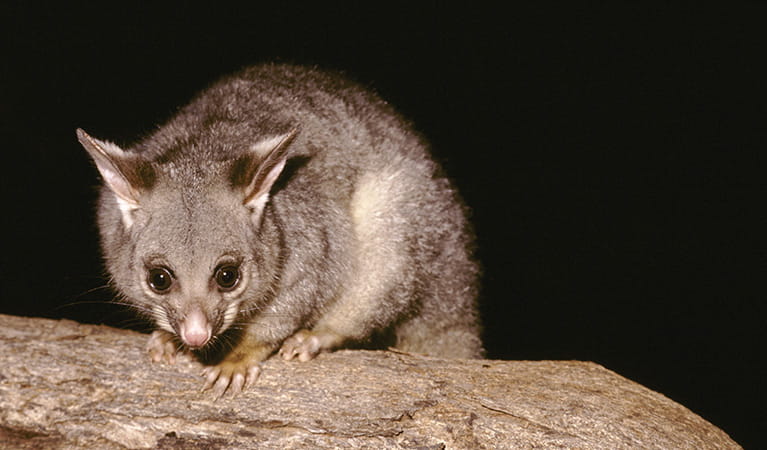
Common brushtail possum (Trichosurus vulpecula)
One of the most widespread of Australian tree-dwelling marsupials, the common brushtail possum is found across most of NSW in woodlands, rainforests and urban areas. With strong claws, a prehensile tail and opposable digits, these native Australian animals are well-adapted for life amongst the trees.
-

Common ringtail possum (Pseudocheirus peregrinus)
Commonly found in forests, woodlands and leafy gardens across eastern NSW, the Australian ringtail possum is a tree-dwelling marsupial. With a powerful tail perfectly adapted to grasp objects, it forages in trees for eucalypt leaves, flowers and fruit.
-
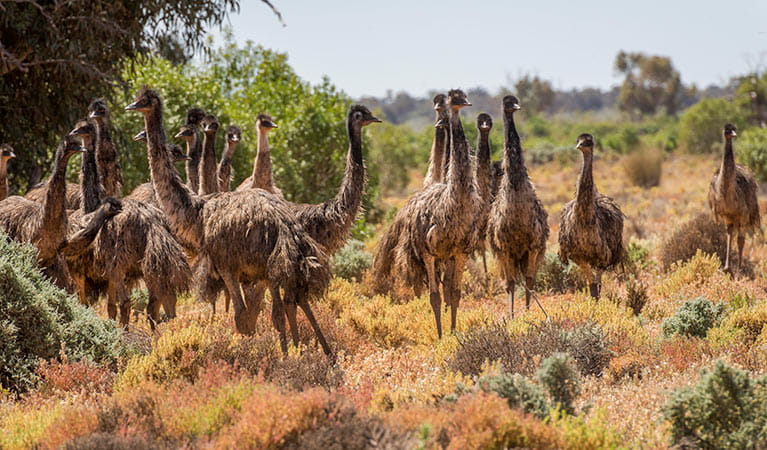
Emu (Dromaius novaehollandiae)
The largest of Australian birds, the emu stands up to 2m high and is the second largest bird in the world, after the ostrich. Emus live in pairs or family groups. The male emu incubates and rears the young, which will stay with the adult emus for up to 2 years.
-
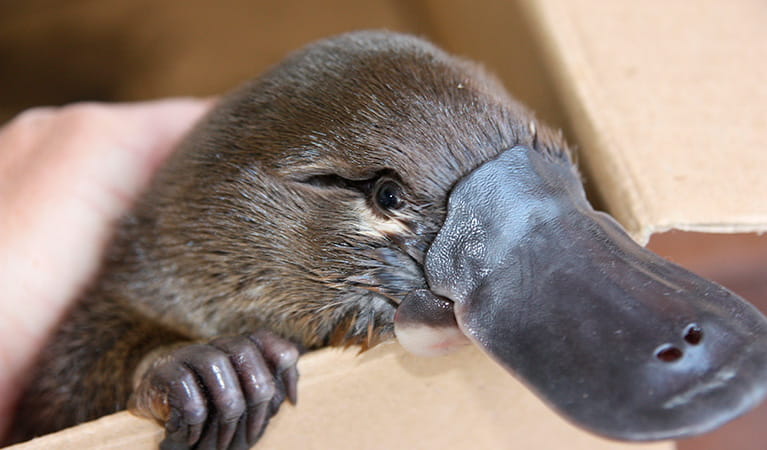
Platypus (Ornithorhynchus anatinus)
One of the most fascinating and unusual Australian animals, the duck-billed platypus, along with the echidna, are the only known monotremes, or egg-laying mammals, in existence. The platypus is generally found in permanent river systems and lakes in southern and eastern NSW and east and west of the Great Dividing Range.
-
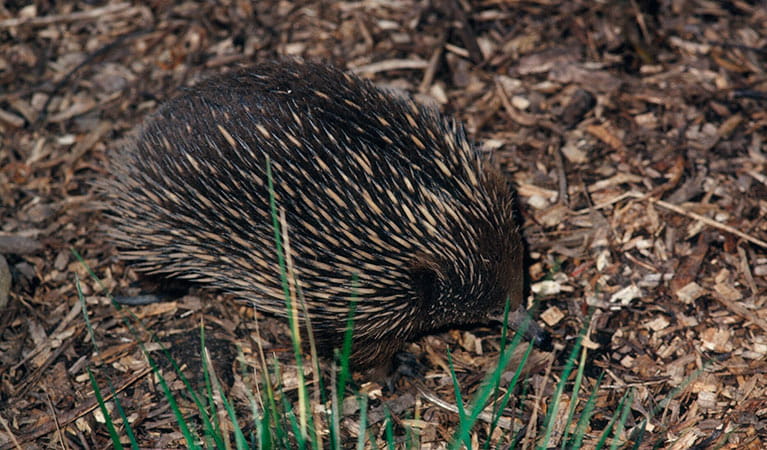
Short-beaked echidna (Tachyglossus aculeatus)
One of only 2 egg-laying mammals in the world, the short-beaked echidna is one of the most widespread of Australian native animals. Covered in spines, or quills, they’re equipped with a keen sense of smell and a tube-like snout which they use to break apart termite mounds in search of ants.
-

Superb lyrebird (Menura novaehollandiae)
With a complex mimicking call and an elaborate courtship dance to match, the superb lyrebird is one of the most spectacular Australian animals. A bird watching must-see, the superb lyrebird can be found in rainforests and wet woodlands across eastern NSW and Victoria.
-

Swamp wallaby (Wallabia bicolor)
The swamp wallaby, also known as the black wallaby or black pademelon, lives in the dense understorey of rainforests, woodlands and dry sclerophyll forest along eastern Australia. This unique Australian macropod has a dark black-grey coat with a distinctive light-coloured cheek stripe.
Plants
-
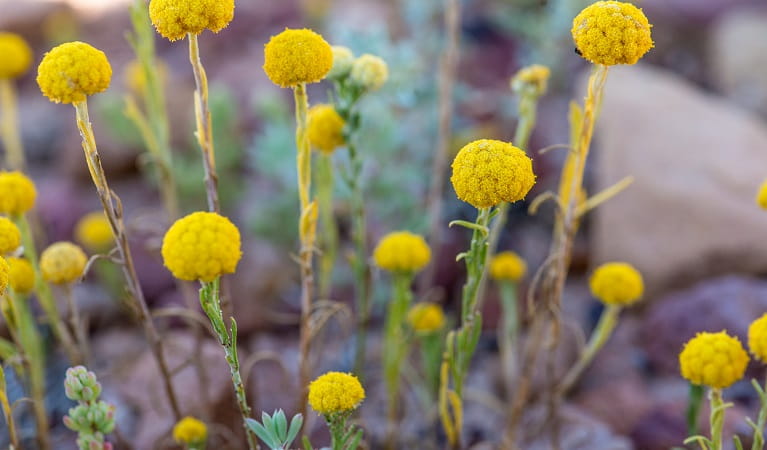
Billy buttons (Craspedia spp. )
Billy buttons are attractive Australian native plants that are widespread throughout eastern NSW in dry forest, grassland and alpine regions such as Kosciuszko National Park. The golden-yellow globe-shaped flowers are also known as woollyheads. Related to the daisy, billy buttons are an erect herb growing to a height of 50cm.

